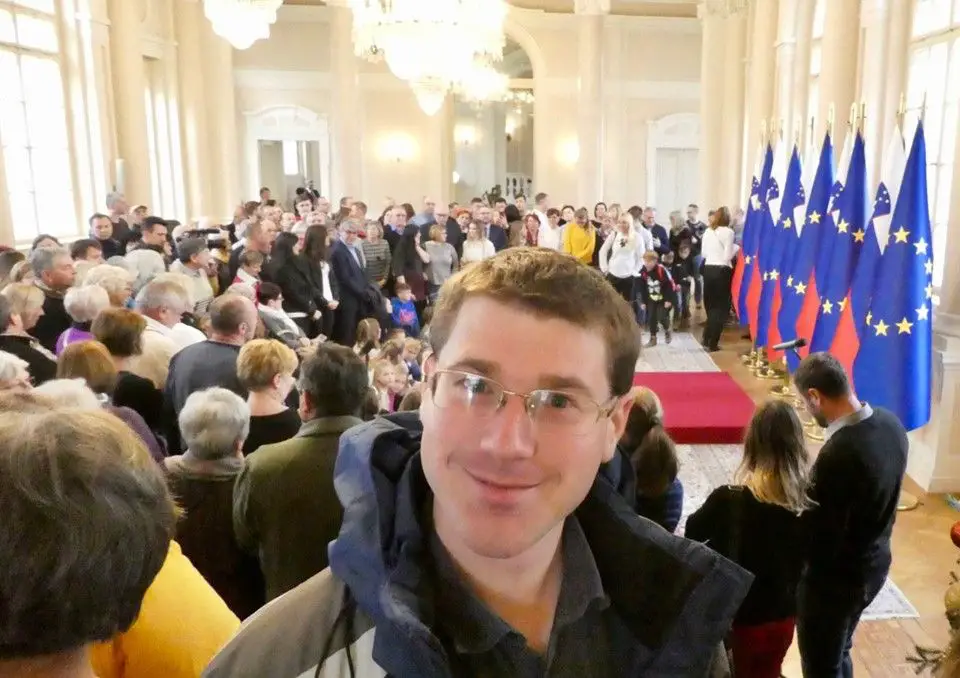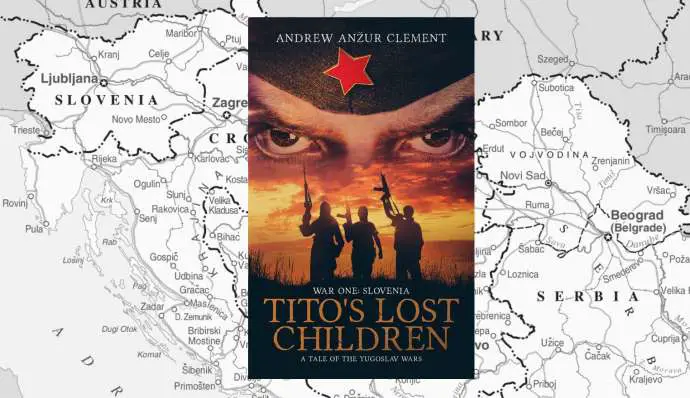Andrew Anžur Clement is a Slovene-American who lives in Ljubljana and is a prolific author, having published eight books in the last 18 months. His latest has just been released, Tito’s Lost Children, and so we made good use of the short time between one project finishing and another starting in earnest to find out more about the work…
For those who might take the title literally - is this really a book about the "missing" children of Tito?
No. While inspired by the breakup of Yugoslavia, Tito’s Lost Children is a work of fiction. The main characters’ actions are set amid real historical events. They meet real historical figures including Milan Kučan, the first president of independent Slovenia. However, the main characters are not based on real people. Tito’s Lost Children is a ‘What if?’ alternative history where the main character discovers that she is Tito’s daughter and chosen successor, meant to have been raised and trained in secret. The problem is that she was discovered late and never trained. It is now up to her to stop the breakup of Yugoslavia and keep it from being turned into Greater Serbia.
The book is set during the 1990s – what drew you to that period, and what research did you do?
I was drawn to the idea that a story like this could have happened within our lifetimes, in ‘our’ world -- and if you live in Slovenia or the region, maybe just a few blocks down the street!
A lot of the research consisted of watching old footage of things like the Yugoslav Youth relay, and the Slovenian independence ceremony. I travelled to many of the locations in the novel. There are also a number of works that have greatly shaped Tito’s Lost Children (Book One) and the forthcoming books in the series. The highlights are below:
The Death of Yugoslavia by Laura Silber and Allan Little is basically my ‘bible.’ A well-thumbed copy sits next to my computer at all times while I’m writing. It is perhaps the seminal work written in English on the wars and provides a detailed overview.
Related: The Slovenian part of the BBC documentary series on which The Death of Yugoslavia was based
Slovenia 1945: Memories of Death and Survival after World War Two by John Corsellis was indispensable to my understanding of the conflict between the partisans and the domobranci in Slovenia during WWII. I read it by chance while cat-sitting for a friend in Bled; I was glad I did. The plot of Tito’s Lost Children would not have been the same without it.
Related: An interview with John Corsellis
Logavina Street by Barbara Demick provides an enthralling and informative account of what it was like to live through the wars, specifically during the siege of Sarajevo. It has been helpful not only for that, but also for providing details about what it was like to live in the region at the time.
To End a War by Richard Holbrooke is a memoir penned by the man who negotiated the Dayton peace accords, bringing an end to the war in Bosnia. It provides an inside account of the negotiating process and has been helpful as a look into what some of the main political leaders in the region, such as presidents Tudjman, Izetbegović and Milošević, were like in person. My characters will encounter them in the coming two books.
Tito and the Rise and Fall of Yugoslavia by Richard West is by far the best historical overview about the origins of ethnic/religious tensions in the region.
Currently, I am reading The Hotel Tito by Ivana Bodrožić. It’s an autobiographical, first person novel about an internally displaced girl during the wars. It is great character research for one of my protagonists, who has a similar backstory; I’ll leave you guessing as to which one.
Did you do much traveling to the other parts of ex-Yugoslavia?
Yes, but most of it not specifically to research these books. I live in Ljubljana and have been travelling to the region of the former Yugoslavia for over ten years, so it’s more like my travels were the inspiration for the books. I got the explicit idea to write Tito’s Lost Children while on a family vacation in Montenegro and southern Croatia in the summer of 2017. The inspiration for it struck while I was standing on the dais behind Montenegrin King Njegoš’s tomb. I spent the rest of the trip creating the characters and envisioning them inhabiting places like Dubrovnik, the Sveti Stefan resort island and the cliffside Ostrog Monastery. Since then, I traveled back to Sarajevo and Pale in January specifically to do research for the books. I am planning a research trip back to Serbia later this month.
I should mention that the city of Ljubljana figures prominently in Book (War) One. It’s sometimes funny for me to walk around town now. I have associations with what my characters ‘did’ in some places. Cankarjevo Nabrežje? That’s where Hristijan was awestruck when arriving in Ljubljana for the first time. Shoemaker’s Bridge? That’s where Mojca was when the helicopter got shot down during the Ten-Day War. Prešeren Square? Well, I’d tell you, but then I’d have to give a major spoiler…
Aside from the places that mentioned above, many other locations in Ljubljana figure in the second half of the novel once the characters make it to Slovenia – which is a lot harder than it sounds, believe me! They include: the river walk in Trnovo, Congress and Republic squares, and Metelkova when it was still an Army barracks.
I was lucky enough to get a peek inside of the Slovenian Presidential palace when President Pahor opened it to the public on December 26th. It figures as a prominent location during the Ten-Day War.
Outside of Ljubljana, some of the plot is set during the conflict over the Holmec border crossing in the north of Slovenia. The summit of Mount Triglav provides the setting for the climax.

Andrew inside the Presidential Palace. Source: Andrew Anžur Clement
Your earlier works had magic and fantasy, are there any elements of those in Tito’s…?
Nope. No magic or fantasy. Just a lot of hard-core identity politicking among the Yugoslav peoples. Don’t worry, I make it entertaining, if I do say so myself.
This book is subtitled “A Tale of the Yugoslav Wars. War One: Slovenia” – how many books are planned for the series?
Three, one ‘war’ (book) for each of the main conflicts that occurred during the breakup of Yugoslavia in the early 1990s. I currently have a draft of ‘War’ Two, Croatia, which centres on the Sieges of Dubrovnik and Vukovar. I can’t wait to start writing ‘War’ three Bosnia, which centres on the Siege of Sarajevo and the Srebrenica massacre.
I should mention that I also have an idea for a sequel series to Tito’s Lost Children, set in the former Yugoslavia and Brussels during the mid- 2010s. The working title is Daughter of the Federation and it draws heavily on my PhD student days in the EU’s capital city during that time.
How much of the series do you have plotted out, and how much of an outline typically makes it to the final book?
In a general sense the series is plotted out all the way through to the end. In other words, I know how the characters will develop and what happens to them. I tend to deal with their specific internal monologue and how exactly they react to certain events on the fly. As a general rule, I usually know I’m ready to begin writing a new series when I have enough plotted out to know the first and last sentences.
Usually, I whack out 30% of a complete first draft. There are sometimes things in earlier drafts that were only in there because I first had to explain what happened to myself before I can ‘show’ it to the reader. This is just part of the process.
Do you envision a Slovenian edition of the book?
I currently sell the book on mainly Amazon and am focused on the English-speaking market. I wrote these books with the assumption that many people picking it up in the English speaking world might not have extensive knowledge of the region or its history. So, if I’ve done my job, someone should be able to read it without first knowing, say, the difference between a Slovene and a Serb, enjoy the adventure story, and maybe learn a thing or two.
That said, I don’t think that means the book is unenjoyable to Slovene audiences; since the book launched, I’ve been surprised by the amount of interest coming from Slovenes. Someone even messaged Marjan Šarec and Miro Cerar about the book on Twitter! Maybe having a Slovene translation of it would make sense.
Do you think self-publishing like this is a viable way for authors in Slovenia, who are a long way from traditional publishing centres, to produce, market and sell their work?
If we’re talking about self-publishing on an online platform like Amazon, I would say it’s the best way out there if we’re talking about the international market. It bypasses the London and New York-based agents and publishers and gets your ideas out there right away.
If we’re talking about sales in Slovenia, where ebooks aren’t so popular, I have heard that self-publishing print books with what in the US would be called a ‘vanity press’ and then selling them through online advertising is much more viable because of the smaller size of the market.
Anything else you’d like to add?
As an indie author I live and die by reviews; while I’ve sold plenty of books hardly anyone seems to leave them. Tito’s Lost Children: War One is available for less than the cost of a couple of rides on the Ljubljana bus system. I’d appreciate it if readers could get in touch by leaving a review on Amazon, even if it’s just a sentence or two to let me know their thoughts.
You can pick up a copy of Tito’s Lost Children on Amazon, now on discount for a limited time or free to read with Kindle Unlimited. You can also see Andrew’s other books here.






